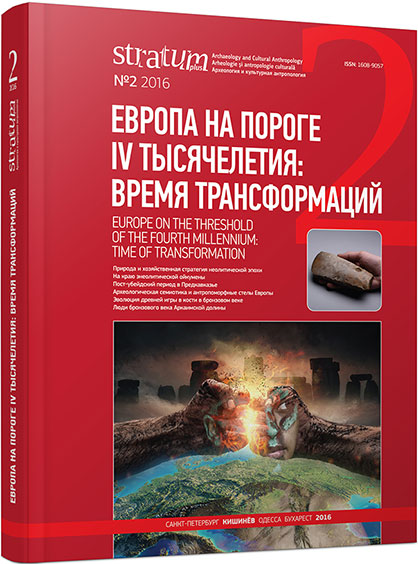«Затянувшаяся путина»: Неолитическое рыболовство и собирательство на Нижнем Дону (по материалам исследований поселения Раздорская II)
“One Protracted Fishing-Season”: Neolithic Fishing and Riverine Gathering in the Lower Don Basin (a Case Study of Razdorskaya II Site)
Author(s): Andrei V. Tsybriy, Victor V. Tsybriy, Alexander F. GorelikSubject(s): History, Archaeology, Economic history, Social history, Ancient World
Published by: Издательский дом Stratum, Университет «Высшая антропологическая школа»
Keywords: Lower Don Basin; Neolithisation; “riverine cultures”; fishing; riverine gathering
Summary/Abstract: A significant increase in the exploitation of aquatic resources is a considerable trait of the Post-Pleistocene adaptation, which was wide spread in the Old and New World. One of its specific regional models appeared in the Sea of Azov region around 7,200—6,800 cal BC under the impacts from Caucasia and especially Zagros region of the Middle East. Here some mighty shell mounds (Razdorskaya II, Rakushechnyi Yar) were explored, with their deposition history amounting to several thousand years. These layers consist of many artifacts, faunal remains, including bones of settled and anadromous fishes. Fishery was carried out probably with use of the net and boats, with weirs in the narrow arms of Don between shoreline and islands. There are numerous pits in the foreshore zone, which apparently were used as temporary receiver of fish or midden. It is possible that the appearance of the shell mounds — these specific tells — could imply accomplishment of at least a semi-sedentary way of life and control over the most beneficial for fishing territories of the river shores and probably over stable weirs, traps, enclosures, certain stability of the economic, social system and ideology in many generations. We suppose that this economic, social and ideological model not so much promoted and accelerated Neolithisation in direction of farming society as probably braked and suspended it. A shift to the actual Neolithisation was possible only in Eneolithic, owing to the activation of external factors of historical process.
Journal: Stratum plus. Археология и культурная антропология
- Issue Year: 2016
- Issue No: 2
- Page Range: 133-173
- Page Count: 41
- Language: Russian
- Content File-PDF

